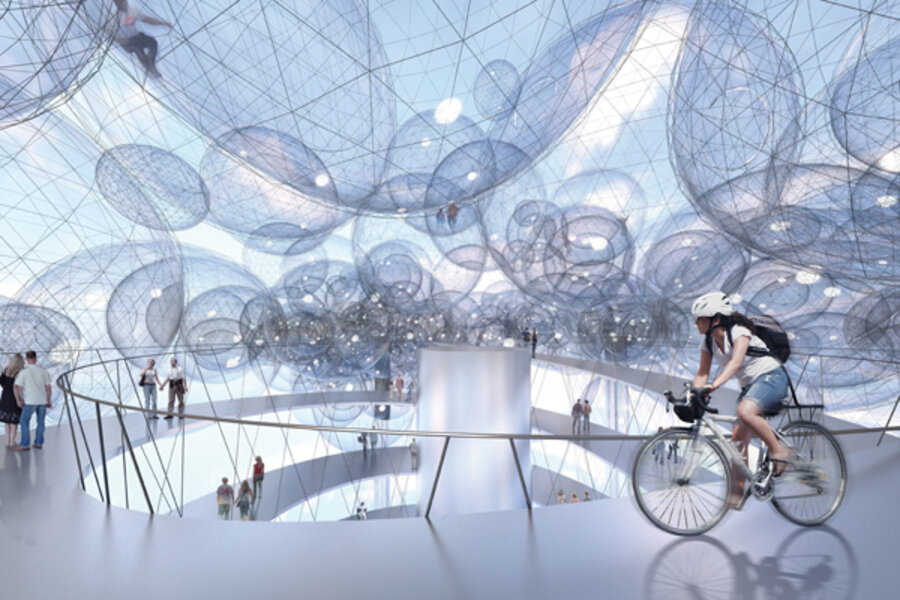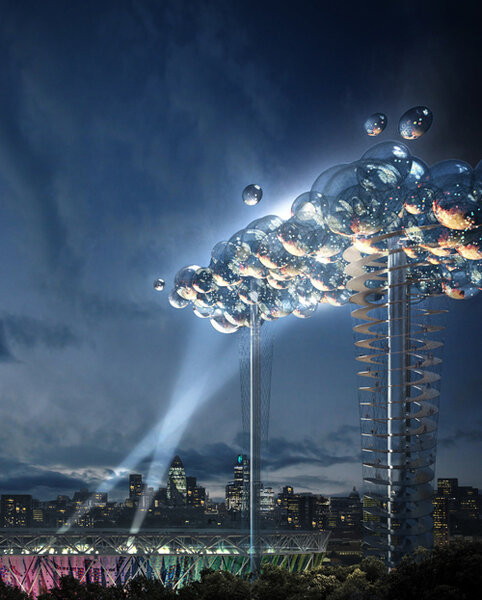For Olympic Games, London dreams of a Cloud castle
Loading...
A group of architects, artists, and other big thinkers are certain that they don’t have their heads in a cloud as they plan what could be the most startling structure to emerge from the London Olympic Games of 2012.
Called simply “the Cloud,” the monument would consist of two slender towers rising hundreds of feet into the air. Atop the twin spires float digital displays and viewing platforms for the public, who would climb up by foot or bicycle using spiral ramps wrapped around one of the towers. The summit would also feature giant inflated plastic spheres, some of which visitors could enter. Real-time information about the Games and the surroundings would be displayed by Google.
In an emerging century with more and more online experience, the Cloud aims to form a connection from the virtual world to the real world, “from the world of bits to the physical world, the world of atoms,” says Carlo Ratti, head of the SENSEable Cities Laboratory at the Massachusetts Institute of Technology in Cambridge, Mass., and a member of the international team working on the project. Other players include Arup, the architectural firm that designed the Sydney Opera House. Umberto Eco, the Italian philosopher and popular novelist, is serving as an adviser.
The Cloud team wants both the finished product, and the way it is conceived and financed, to be revolutionary. While traditional monuments emphasize their grandeur and permanence by expressing a sense of mass and weight, the Cloud “upturns the monumental tradition” with its airy, almost ephemeral design, says Sarah Goldhagen, architecture critic for The New Republic.
“I think the idea is incredibly cool,” she says. Ms. Goldhagen, who also edits an academic journal on modern architecture, is one of three experts the Monitor asked to look at the plans for the Cloud, which are posted online at raisethecloud.org.
The Cloud is designed to be “carbon neutral,” creating the energy it needs to operate from the use of regenerative brakes (similar to those used on hybrid cars). While visitors put in the initial effort by climbing the monument, the Cloud scheme then produces electricity as an elevator lowers visitors back to the ground. Solar panels will also generate electricity.
An Internet-based effort
The design team, which has met only once, last summer, includes members in Britain, Germany, Italy, Australia, and the United States. It mostly works over the Internet with little formal structure, though Professor Ratti at MIT is acting as a coordinator.
The project is among a handful being considered by London Mayor Boris Johnson to become an official part of the London Games.
But even if the Cloud isn’t chosen by the mayor, its designers plan to find an appropriate venue in London in which to build it in time for the Games. “We can build our CLOUD with £5 million [$8 million] or £50 million,” says Ratti on the group’s website. “The flexibility of the structural system will allow us to tune the size of the CLOUD to the level of funding that is reached.”
The group will raise funds via the Internet using social-media sites such as Facebook and Twitter.
“[W]e would like the Cloud to become a symbol of global ownership built through a bottom-up fundraising effort,” Ratti says on the website, akin to the effort used by President Obama’s campaign to collect a large number of small donations online.
The idea of a cloud also evokes “cloud computing,” the concept of storing, manipulating, and sharing data online rather than in an individual computer. Ratti also uses the high-tech buzzword “crowdsourcing” to indicate how he expects a wide number of people to contribute thinking and funding to the effort.
Google says it will supply content for the Cloud’s digital displays, using Google Trends, Google Maps, and its social-networking feature Google Latitude. “For instance, we could provide a custom feed of (aggregated and anonymous) searches made by Londoners during the Olympics to give a real time ‘barometer’ of the city’s interests and mood,” reads a statement from the search-engine giant. In addition, Google promises free advertising for the project through its website and YouTube, including fundraising efforts.
Google’s feeds, Ratti says, could provide information to viewers near the Cloud about “energy use, spectator numbers, decibel levels, medal updates, transport patterns, mobile phone activity, Internet traffic, and [more].”
The shape of the Could evokes the elongated triangle of the Eiffel Tower standing on its head, something its designers see as itself a metaphor. While that 19th-century monument was a groundbreaking homage to the age of steel and heavy industry at the time, the Cloud involves “a lighter process that produces reams of data rather than plumes of smoke,” writes Dan Hill, a team member and consultant at Arup, on the website.
Could the Cloud become a seminal example of 21st-century architecture? “I very much hope so. I mean, I can’t think of a precedent like it,” says team member Alex Haw, a London-based artist who trained as an architect. He contrasts the Cloud to the London Eye, the giant observation wheel that opened on the banks of the River Thames in 2000 as part of the millennium celebration. The operators of the Eye claim it is now London’s most popular paid tourist attraction.
“The Eye is almost an 18th-century phenomenon, really, a 19th-century structure,” Mr. Haw says. “It’s an incredibly old-fashioned idea, a Ferris wheel.... We hope the Cloud will be a good example of something that could replace it.”
The chief challenges ahead, Haw says, are finding a large donor, whose commitment would then attract smaller donations, and looking for an appropriate building site.
Best use of resources?
Experts contacted by the Monitor remain intrigued by the Cloud, while expressing some reservations. “The real test will be whether the carbon footprint of this large-scale design will fulfill the original intentions,” says Mikyoung Kim, an environmental artist, urban designer, and professor at the Rhode Island School of Design in Providence, in an e-mail. “I look forward to seeing ... this design concept come to fruition and only then can an assessment about its innovation be understood.”
Peter Bohlin, a partner at Bohlin Cywinski Jackson in Wilkes-Barre, Pa., questions whether physical projects on this scale are appropriate given the world’s economic predicament. “One wonders if one can do many of these things in a more modest way that is more resource sensitive, and be more touching in the process,” says Mr. Bohlin, who was honored by the American Institute of Architects with its Gold Medal, the profession’s highest individual honor, in December. “I don’t know, but certainly these are questions.”
Bohlin adds that he doesn’t mean to sound negative. It’s “a wonderful, extraordinary challenge and one that interests me ... greatly,” he says. But in trying to employ cutting-edge technologies, the Cloud may confront long-range problems. “You can very easily be trapped in those technologies” after hitting unforeseen complications, he says.
“The Cloud is quite ethereal,” he says. “It’s really an interesting challenge how to make ephemeral things out of real materials.... It is hard to make dreams out of physical things.”
Some of the technologies may not work as expected, The New Republic’s Goldhagen points out. Each of them “has to pan out in the way they say it will in order for this monument to have the kind of effect that they are hoping it will,” she says. “We all should wish them absolutely the best and cross our fingers that they’re going to be able to [get it built].... These people are very cutting-edge engineers, so maybe they’re going to be able to pull it off.”
Team member Ratti, for one, says he’s optimistic that when the Olympics open in 2012 the Cloud will be a technological marvel floating overhead – and for a long time to come. “Hopefully, like the London Eye, it will stay forever,” he says.
[Editor's note: The original version of this article misstated the Cloud's Web address. It's raisethecloud.org.]






